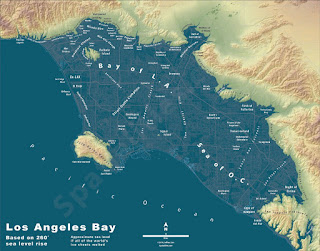The Gulf of Los Angeles
I posted yesterday about a possible tipping point in melting ice on the Antarctic and Greenland, and the danger that the rise in the sea level may be abrupt. Today we have some confirmation about the Antarctic ice:
Warm waters melting Antarctic ice shelves have appeared for the first time in over 7,000 years
Warm waters melting Antarctic ice shelves have appeared for the first time in over 7,000 years
The ocean surrounding Antarctica is extremely cold, but water over 300m deep, Circumpolar Deep Water (CDW), is about 3⁰C above the melting point of ice. Normally, the very cold water above keeps this away from ice shelves. But in some areas, CDW is spilling onto the shallow Antarctic continental shelf, causing the ice to thin.
Ice shelf thinning has accelerated in recent decades, but the picture is not the same everywhere. While the east of the Antarctic has shown modest gains in ice thickness, the west has outstripped this with significant ice loss – up to 18% in vulnerable areas like the Amundsen and Bellingshausen Seas.
The pattern of ice loss and other observations indicate that warmer water upwelling beneath these ice shelves is driving it. But what has caused this upwelling? Is it related to human activity? And how concerned should we be?
If this abrupt increase in the sea level does occur, we know that Miami and New Orleans, but how about Los Angeles. Or maybe we need say the "Gulf of Los Angeles" and the "Sea of Orange County:
CALIFORNIA DOESN’T HAVE A FUTURE ACCORDING TO RISING SEA LEVELS
“Until 2050, there are minor differences in sea-level rise projections based on greenhouse gas pollution scenarios. They diverge significantly past midcentury, the study said. It gave possible sea-level rise amounts looking at three California locations where there are tide gauges: Crescent City in northern California, the Golden Gate Bridge in San Francisco and La Jolla in San Diego.” — Anne C. Mulkern (Journalist at the Scientific American)



Comments
Post a Comment